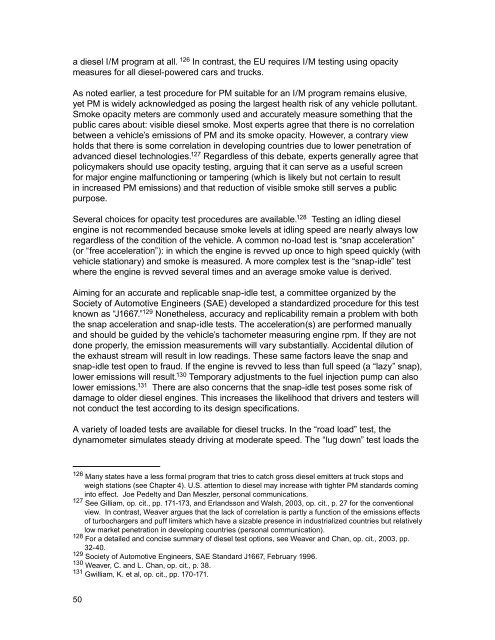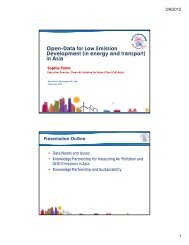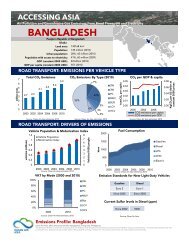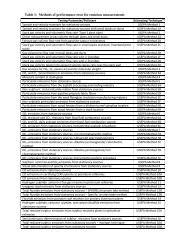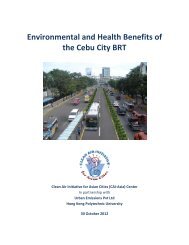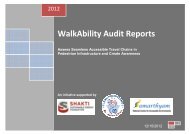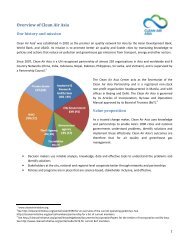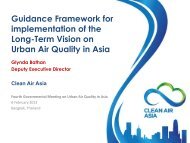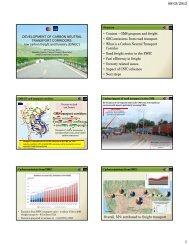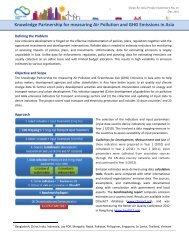International Experience and Best Practices - Clean Air Initiative
International Experience and Best Practices - Clean Air Initiative
International Experience and Best Practices - Clean Air Initiative
You also want an ePaper? Increase the reach of your titles
YUMPU automatically turns print PDFs into web optimized ePapers that Google loves.
a diesel I/M program at all. 126 In contrast, the EU requires I/M testing using opacity<br />
measures for all diesel-powered cars <strong>and</strong> trucks.<br />
As noted earlier, a test procedure for PM suitable for an I/M program remains elusive,<br />
yet PM is widely acknowledged as posing the largest health risk of any vehicle pollutant.<br />
Smoke opacity meters are commonly used <strong>and</strong> accurately measure something that the<br />
public cares about: visible diesel smoke. Most experts agree that there is no correlation<br />
between a vehicle’s emissions of PM <strong>and</strong> its smoke opacity. However, a contrary view<br />
holds that there is some correlation in developing countries due to lower penetration of<br />
advanced diesel technologies. 127 Regardless of this debate, experts generally agree that<br />
policymakers should use opacity testing, arguing that it can serve as a useful screen<br />
for major engine malfunctioning or tampering (which is likely but not certain to result<br />
in increased PM emissions) <strong>and</strong> that reduction of visible smoke still serves a public<br />
purpose.<br />
Several choices for opacity test procedures are available. 128 Testing an idling diesel<br />
engine is not recommended because smoke levels at idling speed are nearly always low<br />
regardless of the condition of the vehicle. A common no-load test is “snap acceleration”<br />
(or “free acceleration”): in which the engine is revved up once to high speed quickly (with<br />
vehicle stationary) <strong>and</strong> smoke is measured. A more complex test is the “snap-idle” test<br />
where the engine is revved several times <strong>and</strong> an average smoke value is derived.<br />
Aiming for an accurate <strong>and</strong> replicable snap-idle test, a committee organized by the<br />
Society of Automotive Engineers (SAE) developed a st<strong>and</strong>ardized procedure for this test<br />
known as “J1667.” 129 Nonetheless, accuracy <strong>and</strong> replicability remain a problem with both<br />
the snap acceleration <strong>and</strong> snap-idle tests. The acceleration(s) are performed manually<br />
<strong>and</strong> should be guided by the vehicle’s tachometer measuring engine rpm. If they are not<br />
done properly, the emission measurements will vary substantially. Accidental dilution of<br />
the exhaust stream will result in low readings. These same factors leave the snap <strong>and</strong><br />
snap-idle test open to fraud. If the engine is revved to less than full speed (a “lazy” snap),<br />
lower emissions will result. 130 Temporary adjustments to the fuel injection pump can also<br />
lower emissions. 131 There are also concerns that the snap-idle test poses some risk of<br />
damage to older diesel engines. This increases the likelihood that drivers <strong>and</strong> testers will<br />
not conduct the test according to its design specifications.<br />
A variety of loaded tests are available for diesel trucks. In the “road load” test, the<br />
dynamometer simulates steady driving at moderate speed. The “lug down” test loads the<br />
126<br />
Many states have a less formal program that tries to catch gross diesel emitters at truck stops <strong>and</strong><br />
weigh stations (see Chapter 4). U.S. attention to diesel may increase with tighter PM st<strong>and</strong>ards coming<br />
into effect. Joe Pedelty <strong>and</strong> Dan Meszler, personal communications.<br />
127<br />
See Gilliam, op. cit., pp. 171-173, <strong>and</strong> Erl<strong>and</strong>sson <strong>and</strong> Walsh, 2003, op. cit., p. 27 for the conventional<br />
view. In contrast, Weaver argues that the lack of correlation is partly a function of the emissions effects<br />
of turbochargers <strong>and</strong> puff limiters which have a sizable presence in industrialized countries but relatively<br />
low market penetration in developing countries (personal communication).<br />
128<br />
For a detailed <strong>and</strong> concise summary of diesel test options, see Weaver <strong>and</strong> Chan, op. cit., 2003, pp.<br />
32-40.<br />
129<br />
Society of Automotive Engineers, SAE St<strong>and</strong>ard J1667, February 1996.<br />
130<br />
Weaver, C. <strong>and</strong> L. Chan, op. cit., p. 38.<br />
131<br />
Gwilliam, K. et al, op. cit., pp. 170-171.<br />
50


